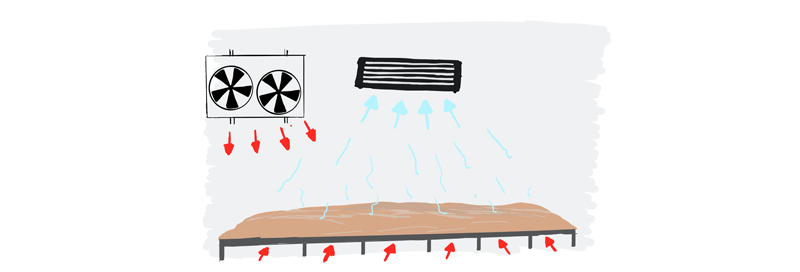- No products in the cart.
I+D+T
(Innovation+ Development+ Tradition)
The experience that our more than 100 years in the flour sector give us, together with our restless and nonconformist spirit and a long time of research, have led us to take advantage of a technique as simple as germination to improve our cereals.
At the moment the seed awakens and begins its sprouting process, a series of internal phenomena take place within it that predispose its nutrients, until then stored and protected, to be able to use them later in its growth, in simpler ways that it can better absorb the embryo that will give rise to the new plant.
At Alere, we wanted to use this state to achieve greater nutritional efficiency in our cereals and then be able to apply them in traditional processes, improving recipes and enriching food naturally.
Elaboration
The process of making our germinated flours always begins with the harvest.
All our cereals come from environmentally friendly farmers and, respecting this dogma,
we source the crops closest to us.
1: Harvest

Harvest of organic cereals of the best quality.
2: Cleaning and selection.

In order to achieve a homogeneous germination of the grains, we apply a sieving in which impurities and grains that are damaged and of too small size are eliminated.
3: Soaking.

In order for the germination processes to start inside the grain, it is essential to provide it with water. To do this, we immerse the cereals already clean and selected in tanks designed for this purpose and immersion phases are interspersed with aeration phases that allow the grain to have the oxygen it needs to sprout at all times, while eliminating the CO2 produced in its breathing. All this is done at a controlled temperature. Once the grain has reached the humidity we want, we move on to the next phase.
4: Controlled Germination.

In the germination phase, the partial degradation of grain compounds such as: starch, proteins, lipids and phytates takes place. This degradation is carried out by the enzymes that began to be synthesized when we put the grain to soak. At Alere Vital we germinate our cereals by the traditional method, placing the soaked grains on a porous bed that allows air circulation and stirring every so often (as we see in the image) so that the grain breathes, to maintain a homogeneous temperature throughout the bed and, at the same time, to avoid the rooting of some grains with others. Once the grain has reached the desired degree of modification, which is marked by the average size of the rootlets and the acrospy, we consider the germination phase finished. We thus seek to always have a homogeneous product that provides us with the functional and nutritional qualities that we desire.
5: Low temperature drying.

This stage is essential to stop the germination process of the grain, thus preventing it from continuing to grow until it becomes a new plant. In addition, with drying, we are able to increase the useful life of our sprouted flours and cereals, going from a humidity of 45% to 10%. This is the main difference with fresh sprouts. The drying is carried out progressively at low temperatures to avoid denaturation of the enzymes, which is vitally important for the processes of making sourdoughs. In the case of our sprouted cereals, this is where the production process ends.
6: Grinding in a stone mill.

To obtain our whole wheat germinated flours while maintaining our flour tradition, the germinated cereals are ground in a stone mill, in such a way that they undergo a single crushing at low revolutions, thus achieving a more aromatic flour speckled by the presence of bran.
Nutritional benefits
With germination, the nutritional benefits provided by the three main components of whole grains are enhanced and improved: the germ, the bran and the endosperm.

Improved digestibility
During germination, enzymes are formed, such as amylases and proteases, which degrade part of the starch to simpler compounds, and part of the proteins, to amino acids; thus achieving an improvement in digestibility.

Greater bioavailability of minerals
Thanks to the degradation of phytic acid, a compound naturally present in the bran of cereals and which acts as a mineral-binding element.

Synthesis of vitamin E and D
When the growth of a new plant begins, the synthesis processes of new compounds also begin, among them are tocopherols and tocotrienols, which act as vitamin E.

Increased antioxidant capacity
The main antioxidant compounds of the grain are phenolic compounds, which can be found in a soluble form or attached to the components of the cell wall. With germination, cell walls break down and phenolic acids that were attached to these plant structures are released, thus increasing the content of antioxidant compounds.
Germination biochemistry
All the nutritional and functional benefits of our cereals and germinated flours are due to the biochemical processes that develop within the cereal during germination.
The objective of germination is to make all those substances it needs to be able to feed and grow available to the plant. For this reason, a series of hydrolysis reactions are activated in which the more complex compounds such as starch, proteins, lipids and phosphates; they are degraded to simpler forms that can be used by the seedling to grow.
This degradation process begins with the production of plant hormones or phytohormones in the embryo, (mainly gibberellins). In turn, these phytohormones are responsible for inducing the synthesis of hydrolytic enzymes from the cereal bran to the endosperm, which is the part of the cereal where most of the reserve substances are stored. These enzymes belong to the family of hemicellulases, amylases, proteases and phosphatases.
Hemicellulases degrade the cell wall of the endosperm, thus allowing other enzymes such as amylases to enter its interior and releasing phenolic acids that were attached to plant structures.
Alpha and beta amylases degrade a part of the starch to simple carbohydrates (mono and disaccharides), some of them being used by the embryo for its metabolic processes and the rest remaining in the grain in the form of sugars. The other part of the starch is kept as “modified” starch, that is, it is damaged and, therefore, is more easily digestible by enzymes.
Proteases partially degrade proteins to soluble compounds such as oligopeptides, polypeptides, and amino acids; thus increasing its availability.
On the other hand, the phosphatases hydrolyze the phytates that are found in the grain in the form of insoluble complexes formed by the union of phytic acid with minerals (K, Mg, Ca, Mn, Zn and Fe); thus inhibiting its chelating action and releasing minerals so that they can be used by our body.


